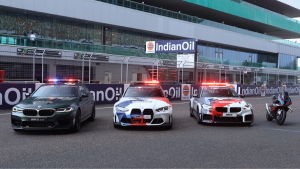BMW F 650 GS road test
The last of line production unit is a strange confection. If the product is a classic, they can be wildly more expensive than usual. But more often than not, they are wildly practical buys, incorporating the full extent of a complete development cycle though missing out on the improvements on the new one. Typically, a last of line unit is an intensely practical, value purchase.
And you are looking at one now. The BMW F 650 GS has been in Indian homologation forever and unfortunately for BMW Motorrad and their exclusive Indian distributors, Navnit Motors, the motorcycle has already been replaced by the F 700 GS in international markets. Which makes the units the F 650 GS you could buy here right now, effectively the last of line. Value proposition? Hold your horses just a moment.
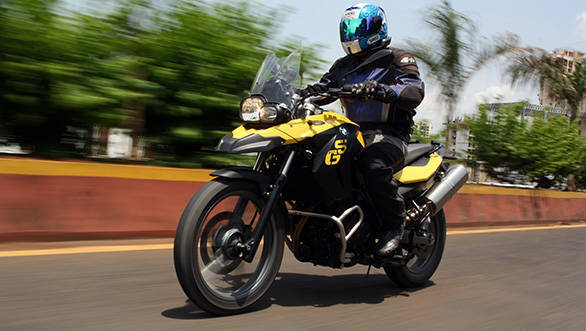 The F 650 GS isn't a GS into the traditional sense of the on-off-road nature of the label. A 19-inch front wheel, that too alloy suggests that off-roading isn't really the F 650 GS' intention
The F 650 GS isn't a GS into the traditional sense of the on-off-road nature of the label. A 19-inch front wheel, that too alloy suggests that off-roading isn't really the F 650 GS' intention
The GS tag towers over the BMW Motorrad product line up. It marks all their on-off-road bikes and given the use pattern, BMW has spent considerable effort ensuring that on-road performance is uncompromised by the need to be able to handle off-tarmac duties. Which is why the Adventure tag was added to certain model variants, where the bits, setup and tuning all spoke to a smaller subset of customers. These are the few who actually intend to use the bike off-road often enough to make a noticeable trade-off in road manners for more dirt oomph.
Experienced riders will quickly point out, for example, that the stock R 1200 GS is actually a far easier road bike to live with than the big tank GS Adventure which feels more unwieldy in daily use because of its big tank and consequent marginally top-heavier feel.
In the case of the F 650, the GS tag then marks a soft roader, sort of like the average soccer mom's SUV, if you will. And I discovered this pretty early in the ride because our photography location required me to spend a fair bit of time on packed dirt and crushed granite (the tarmac is still to come).
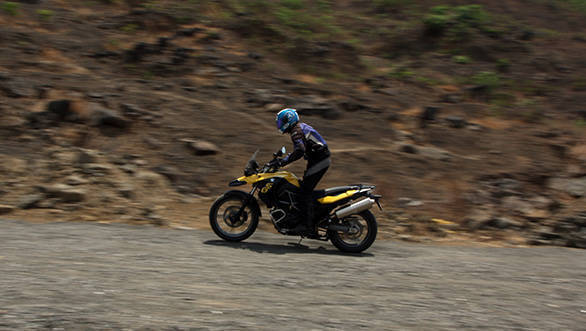 When you do go off-road though, the BMW F 650 GS is quite stable and riding standing up feels natural
When you do go off-road though, the BMW F 650 GS is quite stable and riding standing up feels natural
Once I got used to the slight wander that dirt causes to all motorcycles if you haven't the confidence to add more gas, the GS settled in and was a lot of fun. Standing on the pegs feels completely natural, gripping the bike between the knees and calf muscles is easy and progress is confident and swift. Personally, I'd have backed the throttle response off a bit for loose surfaces but it would have taken the edge off its on-tarmac behaviour.
The road focus becomes clear as soon as you are back on the black stuff. There are visible cues as well. For instance, alloy wheels. Alloys are strong, but neither elastic under stress (as in able to survive a big impact by flexing and then returning to the original shape) nor easy to fix when things go pear-shaped. Which is why all serious off-road motorcycles get spoked wheels. Spokes are bendy and they are easy to replace. Similarly trueing a steel or even aluminium rim is far easier than a cracked alloy. Then come the tyres.
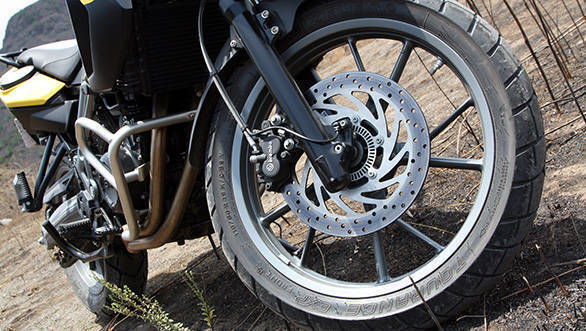 19-inch front rim wears a block tread tyre. These are currently fashionable on adventure segment motorcycles because they handle off-road work without significantly compromising on-road behaviour
19-inch front rim wears a block tread tyre. These are currently fashionable on adventure segment motorcycles because they handle off-road work without significantly compromising on-road behaviour
This big block pattern has found considerable, er, traction in this soft-roader segment because the big tread blocks allow some amount of hook up off road while putting a decent amount of rubber on the road for more than adequate road riding abilities.
But when you do ride on tarmac, the tyres or the grip available isn't the first thing that you will notice. What takes you by surprise is the engine. BMW created the 800cc parallel twin format a few years ago to be able to create a line of less expensive, easy to live with motorcycles. Today, BMW offers this engine in a slightly different state of tune for the smaller GS motorcycles. In fact, the F 800 GS has the 85PS 800cc twin while the new 2013 F 700 GS has the, erm, same 800cc twin, now making 75PS. And our F 650 GS has, you guessed it, the same 800cc twin making 71PS at 7,000rpm. It also makes 74.5Nm at 4,500rpm.
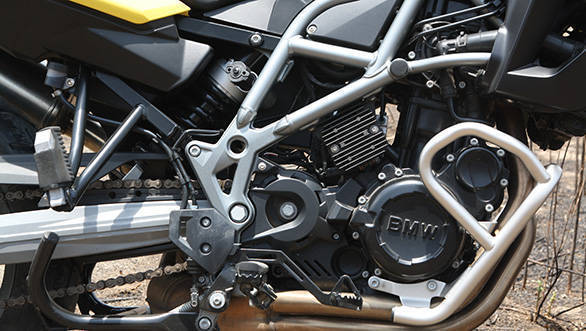 The lowest state of tune for the 795cc BMW parallel twin brings 71PS. The F 800 GS, a proper GS, gets 14PS more from the same engine
The lowest state of tune for the 795cc BMW parallel twin brings 71PS. The F 800 GS, a proper GS, gets 14PS more from the same engine
These aren't earth-shattering figures and you could successfully argue that the Ninja 650, for instance, offers similar engine performance from a smaller engine. But trust me, the first time you open the throttle you'll be baffled. Throttle response is instant and the torque output off idle is impressive.
Which means acceleration is arm-stretching in nature and will require a momentary sensory reset. However, the F 650 GS actually manages 100kmph in 5.23 seconds, making it quick but not exceptionally so. Where the flexibility of the engine really comes through are the roll-on figures. Top speed is around 185kmph, though unfortunately, we ran out of space post 153.62kmph during the test.
Another quirk is that the engine feels a bit rougher and more strained past 5,500-6,000rpm, which eventually leads you to shifting up well before the power peak. It doesn't seem to slow up the bike, though so no loss.
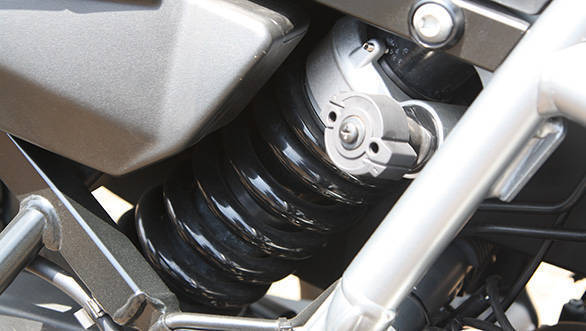 The rear monoshock peeks out from behind the frame. Suspension is basic compared to other GS models but it does work well. Ride is well damped but supple enough to absorb the worst without any trouble
The rear monoshock peeks out from behind the frame. Suspension is basic compared to other GS models but it does work well. Ride is well damped but supple enough to absorb the worst without any trouble
Also even-tempered is the ride quality. The bike's damping feels sporty but it isn't as stiff as you initially think. It absorbs bumps big and small quite effectively for something not tuned or designed for India. Adding to the sense of accomplished comfort are the upright ergos, a wide comfy seat and I suspect that even two-up or heavily loaded for a tour, the F 650 GS will not change significantly in feel which is an asset for an open road motorcycle.
Handling is a stable, neutral confident attribute as well. It is neither super quick into corners nor lazy. You quickly settle into a mental mode where you expect the motorcycle to obey your steering inputs faithfully. This overcomes the fact that in terms of feel, the F 650 GS is a bit cold in the handling department.
Then comes the matter of styling. Which is a mixed bag. It clearly belongs to the GS line in the way it sits on tall suspension, seat height is a bit high and the tank, instruments et al are clearly GS-inspired or derived. Which makes accepting the quirks like the left-side mounted exhaust, asymmetric head lamps etc easier to accept. Build and finish levels, it goes without saying, are excellent.
The motorcycle we rode also wore Rs 50,000 worth of optional accessories sold as a kit, which includes the taller screen, LED indicators and tail lamp, the engine case guard and more.
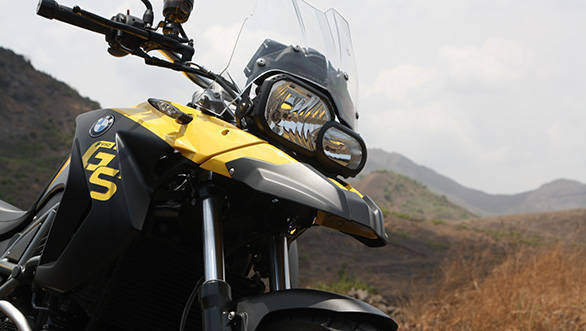 BMW used to be a maker of effective but quirky bikes but they are hard at work eliminating the latter. This one though, not only has the asymmetric head lamps, but also the unique switchgear and old-school meters
BMW used to be a maker of effective but quirky bikes but they are hard at work eliminating the latter. This one though, not only has the asymmetric head lamps, but also the unique switchgear and old-school meters
Without these, the GS will cost you Rs 11 lakh ex-showroom. And before you mental calculators exclaim that is just over twice the price of the Kawasaki Ninja 650, I'd hasten to add that your math is spot on. The BMW is an expensive proposition; there is no way around that.
What you would get for your considerable buck is a friendly, unique motorcycle that will not scare you, do your bidding without any dissent and make you feel like you are in control. As a bonus, it will also happily scamper about in gentle off-roading when the fancy takes you.
The flip side of the price coin however, is this: this motorcycle has already been replaced by the F 700 GS which is how Navnit Motors have been able to secure this price point. Limited numbers are available and Navnit expect to start selling the F 700 GS soon after the monsoon. And the price is expected jump up by another Rs 2 lakh or so.
Which brings us back to the dilemma of the last of line product. The F 650 GS is a solid, garage-worthy motorcycle, though not especially cheap. Its replacement has a bit more power, upgrades the quirky old switchgear to the more conventional newer units, adds a bunch of new electronics and what have you. But it is also Rs 2 lakh more. The question then is simple should you settle or save up?
Here is our video review of the BMW F650 GS
Specs and performance
Engine: Liquid-cooled 798cc parallel twin
Max power: 71PS at 7000rpm
Max torque: 74.9Nm at 4500rpm
Kerb weight: 179kg
Length/Width: 22787 x 889
Wheelbase: 1575mm
Acceleration
0-100kmph: 5.23s
0-400m: 13.83s @ 151.47kmph
Braking:
100-0kmph: 3.47s/48.12m
80-0kmph: 2.66s/28.15m
Efficiency:
City efficiency: 12.23kmpl
Top speed: 153.2kmph (achieved), 185kmph (estimated)
Roll-ons:
30-70kmph in 3rd: 3.96s
40-100kmph in 4th: 5.55s
40-100kmph in 5th: 8.14s
Price: Rs 11,50,000 ex-Mumbai (as tested)
+ Neutral, friendly feel, performance
- Seat height, quirky switchgear, price
Starts Rs 6,24,000
649cc
6-Speed
68.00
64.00
-NA-

